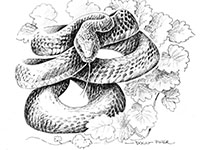The New Career and Technical Education
C&T program brings opportunities for Clarke County students
By Jess Clawson
This month begins a series examining career and technical education in the U.S. in order to help readers more fully comprehend the significance and potential impact of the new programs in Clarke County High School. This installment provides an overview of new local career and technical education initiatives. The next two months will give an overview of the history of vocational training, with insights into the progress of the programs at CCHS. Jess Clawson has a PhD in education history from the University of Florida.
Educators everywhere are concerned about improving the academic performance of students who struggle to achieve in schools, as well as the career and higher education outcomes for high school graduates. Clarke County Schools Superintendent William “Chuck” Bishop is no different. In the December school board meeting, he announced plans for Clarke County High School to begin a career and technical education program for CCHS students.
Clarke County High School has always had courses that filled the CTE role, and this year is incorporating a work-based learning program in partnership with local businesses and industry leaders. Clarke County High School Principal Dana Waring and Director of Curriculum and Instruction Cathy Seal have examined industry data to provide opportunities for students in fields that are hiring.
Twenty students this year will have the opportunity to work with professionals in their area of career interest. “Students will be able to meet with and observe whatever experience comes from those community partners, to determine whether it’s something they want to do and pursue,” says Waring. “For instance, the student who wants to be a physical therapist might realize ‘this might not be for me,’ and those experiences are just as valuable.”
Local business owners who are willing to let students shadow them can offer a variety of experiences to help the students confirm or deny their initial interest in the field. The school is working with about twenty participating businesses covering a wide array of interests, from exotic veterinarians to CPAs to agricultural businesses. They are hoping to expand into opportunities in food service, as well as locations in Winchester, particularly the Old Town Mall.
The degree of hands-on experience varies by placement. For instance, Seal says, a student interested in construction may not be able to do much on the site because of their age, but someone interested in architecture may get to learn how the software works. “They are going to be spending a significant number of hours with the employer in the field,” according to Seal. “We’ve left it wide open, so kids who are involved in sports and extracurriculars can tailor the program to meet their scheduling needs.”
The initiative at CCHS has two major partnerships: Valley Health and Lord Fairfax Community College. Students at CCHS can get their Certified Nursing Assistant credential, and each year three students in the nurse aid program have the opportunity to do a paid internship with Valley Health. This provides economic opportunity, as the pay starts at $15/hour, and supports their college application materials. Prior to placement, they will have completed coursework and other clinical experience like visits to the local nursing home. According to Waring, “the vast majority of [CNA] students go into nursing.”
The cooperation with LFCC will expand upon the hands-on technical education CCHS offers. The local high school may not have the equipment available to give students the chance to learn about things like HVAC, electrical work, or welding. Through their work with LFCC, students will get two certifications and a college credit.
The partnership with LFCC is a consortium agreement and will include students from Warren, Frederick, and Winchester schools, along with Clarke County. Lord Fairfax will take 15 students combined, and CCHS has been allocated three spots. As the program evolves, more spots may become available and more programs offered.
Seal sees this as a tremendous opportunity for students: “Being the size that we are with one high school and a little over 700 students, we have to look to those community partnerships and opportunities that are available, because we can’t offer the variety of pathways and the variety of course offerings within this building,” she says. “We don’t have staff, we don’t have budget, we don’t have space. So that partnership with Lord Fairfax and that partnership with Valley Health is a good attempt to provide kids career exposure.”
Some opportunities for dual enrollment with Shenandoah University are also possible for students, particularly through the sports medicine course at CCHS. The course, taught by sports trainer Lindsey Greigo, is a daily block class with high medical terminology that Waring describes as intense and challenging.
The state is putting increased focus on career and technical education, including widening its reach into middle school. Eighth grade students are meant to have a career pathway document completed with the assistance of a guidance counselor to bring with them to high school. This helps Waring and the high school counselors assist them in choosing the appropriate coursework.
Seal believes this effort should be moved into the elementary division. “We certainly know kids aren’t going to decide in fifth grade what they’re going to be for the rest of their lives,” she says, “But if we can help them start to understand what their strengths are and what they’re naturally interested in and guide them down that path, it would be really helpful.” Seal is part of the Top of the Valley Regional Chamber Committee, and as a function of work on the strategic plan, proposed a project to get fourth and fifth grade students exposed to more career and industry pathways. While teachers might bring architects or other professionals to their classes to talk to students, the entire school is not necessarily exposed to those ideas. “We need to firm up more consistent efforts for kids to realize the vast array of careers,” Seal says.
The school system is doing more career exploration at earlier ages. In the fall semester, for instance, all of the seventh grades in Clarke County, as well as surrounding counties, went to the sports complex in Winchester for a middle school-appropriate career fair. Students would go through the fair and do activities that simulated work in the field. As Seal described it, “They didn’t have a firefighter talking to them about what it was like to be a firefighter…They actually suited up and went through a tunnel that was like a smoke/heat simulation to see what it was like.”
Beginning with the graduating class of 2017, all Virginia students on a standard diploma need a CTE requirement, but are not actually required to take CTE courses. This requirement is fulfilled through a standardized CTE exam. “The interesting piece to me is that they did not mandate that you have to take a CTE course,” says Seal. “They just said you have to pass the test. So I think they have some work to do in that area.” Clarke County will mitigate this problem through having all students take economics and personal finance—also mandated by the state—and using the accompanying standardized exam as their certification.
Subsequent installments will cover more details of the CCHS CTE initiative as well as the historical background that gives context to the local innovations. Next month, the history of Reconstruction and the debates over black education will feature the Josephine School Museum and its place in the vocational versus classical liberal arts education debates.















